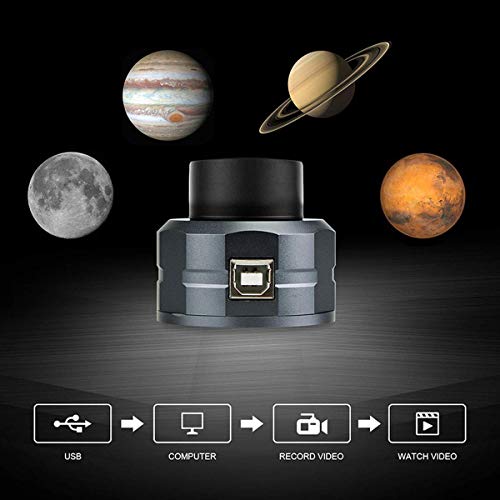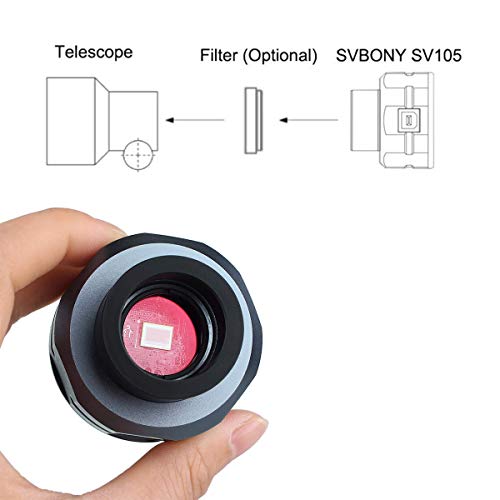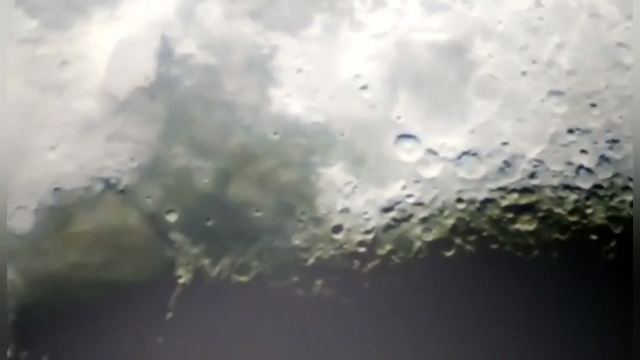- Plug and play ;windows system needs to download Sharpcap Capture; Linux system needs to download AstroDMx Capture; Mac system needs to download oaCapture; Android system needs to download USB Camera. real time dynamic observation by crystal clear image
- Dark light compensation technology;greatly improve the camera's image clarity in low light conditions
- Record 2K video at high speed;up to 30 frames per second at 1920x1080 resolution
- Great for lunar and planetary shots;share the view of bright planets;the Moon and terrestrial targets;not suitable for deep space imaging
- It can connect a 1.25 inch filter and the filter thread is M28.5x0.6;the new SV105 adds filter threads and dust protection window
-
Information
-
Twitter
-
Pinterest
-
Youtube
-
Facebook







Bradley Rollinson
Fantastic budget camera
This is an incredible budget camera that has not let me down since it came out of the box and I have spent many hours with it so far. Sturdy metal design, compact, light weight and easy to use software make it very appealing for beginners. No need to search for drivers to install on Windows. Have only used it for planetary purposes with a 70/700mm achromatic refractor and an 8” 1200mm Dobsonian. Attached are some recent images captured with the Dobsonian (manually guided) of Jupiter, Saturn and Mars.
Peggy Hurst
Uhhhhh yea.....buy this.....
See these photos? They're from the first night out with this camera. The only other astrophotography I've ever attempted was with an iPhone 6. Frustrating, with disappointing results. But with this oddly named little camera? WOW. Pretty unbelievable. I'm using a 6 year old laptop and the software that came with the SVBONY for capture. Somehow it knows which frames to keep, so they are incredibly sharp. My telescope is a super cheap Meade ETX 80 - the backpack model with the super shaky tripod. It was windy, and the seeing was bad too. Didn't seem to bother the SVBONY. All of the above are unstacked frame-grabs, except for Saturn which is a dozen or so frames stacked in registax. Anyway, if you want to dabble in astrophotography a little before dropping $5k on a DSLR, GEM, EPO Refractor, Guide Scope and all that, this is the way to go. The files are small, and the resolution is really good for such a cheap camera.....
Avis Evans
Great telescope camera for the price.
This is the lowest end camera I could find and I really got it to try out a telescope camera attachment before investing in a higher end camera. I was honestly very impressed. There's a software disc that comes with it that was easy to install and start capturing. The easiest thing to do is bring your laptop out with you and connect it to the camera once the telescope is aligned to the planet you want to capture. This camera replaces the telescope eyepiece. Then once the video is recorded I used SharpCap free software to create a composite image from the video you capture with the software that comes with the camera. The attached picture is my best so far. Honestly I was impressed and it's a great camera for the price.
Mariella Busuttil
Great camera at an outstanding price
Due to the price, I initially thought this camera would be just a practice tool for taking some pictures of the moon but it turns out that it performs surprisingly well compared to my DSLR and other CMOS astrophotography cameras. It is nowhere near the cost and the performance is still very good when you consider the price. A great camera for the money!
Sminer Codef
Budget friendly starter planetary camera
Before I even start, I want to say to anyone that has never used a planetary camera before- it's not a point and shoot camera. Before you buy any camera, watch some YouTube videos and learn how they work before you buy one, send it back, and leave a bad review highlighting you're lack of understanding. For the price compared to other starter cameras, this is the best. Both of my photos posted were taken with this camera. The software is very user friendly. I don't think the two companies are really related but you'll get a copy of SharpCap that has limited features but for someone like myself doing this for the very first time, I found it met my needs by not over burdening me forcing me to have professional skills over night just to take a picture. It's given me a great platform to start from and as I learn my limitations, it's helping me before making an expensive purchase to get into deep space imaging.
Sharon Perkins
Great Value
This digital capture device really is a great value. I can't believe for only about sixty bucks I can capture such high-quality snaps of North Hollywood (where I live) from my highrise office suite in Glendale, CA (about 10 miles away). I'm only using a cheap $80 telescope I bought about 10 years ago, which for the past 8 years had been sitting around collecting dust in a closet. I recently dusted it off and brought it to my office and found this capture device and it was an awesome pairing. Now I want to get a better telescope.
Simon Balzan
Great value camera
A good place to start in astrophotography. I’ve seen many good images posted here in the reviews. I’ve included an image of Jupiter with moons that I took with this camera. This image was only about 84 frames stacked. Just have to learn how to edit images in RegiStax or Autostakkert/GIMP and you’re good to go. If you’re thinking about doing AP get this camera. You can get started for a fraction of the price of a ZWO and then if you want to upgrade you’ve already got the experience
Dianne Marsters
Works on Windows 10 computer, recommended as an entry-level camera, aluminum enclosure feels solid.
The SVBONY SV105Camera works as advertised on my Windows 10 computer, my planet images submitted with this review were through a f/8, 6" (152 mm) newtonian telescope with two stacked 2x barlow lenses, on the night of October 9-10, 2020. I used a filter for Jupiter and Mars. The gain should be increased in Sharpcap if your target (like Saturn) is dim (especially when using barlows). The videos you capture will have very large files (6-9 gigabytes per video when shooting at 30 FPS, so make sure you have enough storage space. It helps to have a computer that won't choke on that much data during acquisition (so some old laptops won't be able to handle that much data flow). I would highly recommend using a barlow lens with this camera to get good image scale. The manufacture is right to mention that is not a deep sky camera, knowing that I still tried after the planet session to image the Pleiades with the maximum 500 ms (1/2 second) exposures, I could only see one star on the screen in live view, so don't think about using it for deep space at all (although I've seen others try the more expensive SV305 for that even though it isn't a deep space camera, it had interesting results). I recommend using a motorized telescope at very high magnifications when shooting the planets (or it will leave the field of view immediately). When shooting the Moon without a barlow it should be possible without a motorized scope but it will need to be moved frequently (which can be very difficult!) I also did a live stream on youtube of the Moon with this camera for International Observe the Moon Night using a 12.5" f/6.3 motorized telescope (search for it there on youtube.) Remember to shoot the Moon when it isn't full (so that you can see the craters on the day/night line/terminator) Remember to try to shoot when the planets are near your local meridian (which is only part of the year), and remember that Mars only comes around to opposition every ~two years. I stacked the videos using Registax, but there are other programs commonly used for that too (check out cloudynights website's Solar System Imaging forum to learn more about how to process images.)
Davey Abu Dhabi
Good telescope camera but not for Spotting Scopes
I tried to use this camera on my Zeiss Spotting scope with an adapter. The camera fit into the 1.25 adapter and into my spotting scope and close focused well. The image was very good using android software app for the camera. Unfortunately I could not attain focus past 50 yards. After hours of research I found that my Zeiss Spotting Scope will not focus correctly with an eyepiece that has a field stop greater than 24mm. This camera as well as standard telescope eyepieces have a field stop of 28mm. Other wise this is a very well built, good image, 5mm camera. I gave it 5 stars because I was able to close focus and that image looked very good. If I have an astronomy scope I would have kept this camera. you will not be disappointed with this android capable scope camera.
Misty Rene Freudenberg
Absolutely stunning
My first time using a dedicated planetary camera and this is by far one of the most satisfying moments since I got into planetary and astrophotography. For the value, this thing is a no brainer. For those who aren't quite sure what to expect, whether this hobby is for them or not, or just to be less stressed out over using a phone to image, this is for you. Absolutely amazing for the money. These are my first two images, so I can only imagine the quality will increase with practice. If you're considering a camera, you won't go wrong here.